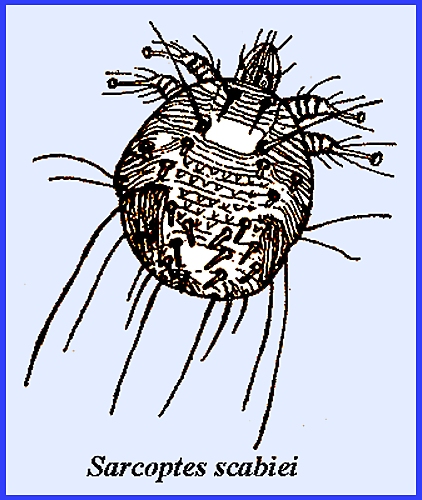File: <acarinamed.htm> <General Index> Site Description Glossary <Navigate
to Home>
|
ACARINA Mites (Contact) Please CLICK on
underlined links to view: [Key to Medically
Important Acarina]
There are many different habits among the mites. They consume mainly body fluids of their
host plants or animals or from decomposing organic matter. Many mites are free-living and predatory,
and many are also parasitic.
Parasitic mites have a great variety of life styles. For example, the ticks are external
parasites of animals, feeding on blood.
Some ticks burrow into the skin and cause itching and subsequent
infections. Other species are found
in the lungs of seals and monkeys.
Chiggers are free-living and herbivorous or predaceous as nymphs and
adults. Many species attack birds,
feeding on their scales and feathers or they may invade the lungs and hollow
bones. Some species attack stored
food products and pass over to humans working close by. Of great importance are the bloodsucking
mites that serve as intermediate hosts of human pathogens.
The identification of mite
species is continuously changing, as they are a difficult group to
study. The position of body hairs is
frequently used for diagnoses.
Acarina that are parasitic may be found primarily in the following
Suborders and Superfamilies: CLICK on following
Groups for Details of Importance
& Control
= = = = = = = = = = = = = = = = = = = =
Key References: <medvet.ref.htm>
Banks, N. A. 1915. The Acarina or mites. U.S. Dept. Agr. Rept. 108. Bishopp, F. C. 1935. Ticks and the role they play in the
transmission of diseases. Rept.
Smithsonian Inst. for 1933: pp 389-406. Bishopp, F. C. & H. L. Trembley.
1945. Distribution of certain
North American ticks. J.
Parasitology:: 31-1-54. Bishopp, F. C. & H. P. Wood.
1913. The biology of some
North American ticks of the genus Dermacentor. Parasitology 6:
153-87. Cooley, R. A. 1942. Determination of Ornithodoros species. In:
Symposium on relapsing fevers in the Americas. Am. Asoc. Adv. Sci. Pub. 18:
77-84. Ewing,
H. E. 1926. Key to the known adult trombiculas (adults of chiggers) of the
New World with descriptions of two new species (Acarina,Trombidoidea) Ent.News 37: 111-13. Ewing,
H. E. 1944. The trombiculid mites (chigger mites) and their relation to
disease. J. Parasitology 30: 339-65. Matheson,
R. 1950. Medical Entomology. Comstock Publ. Co, Inc. 610 p. Service, M. 2008. Medical Entomology For Students. Cambridge Univ. Press. 289 p |
